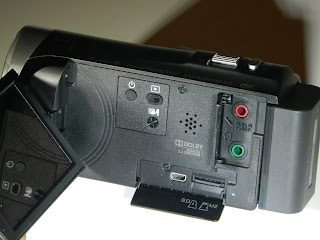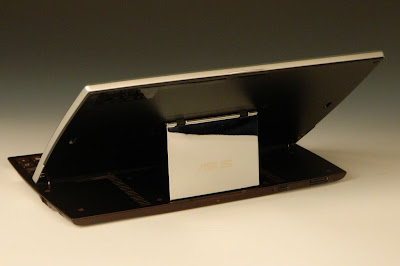My more modern photo cameras, and even my phone can shoot video. Their form factors, internal microphones, and the ergonomics of holding them steady makes them less than ideal (in my opinion) for shooting more than a quick casual video. Rarely do phones or photo cameras come with built-in image stabilization.
A student of mine mentioned that his current digital camera could connect via wifi to his phone for transferring photos he'd shot. This intrigued me to research this current connectivity trend.
Enter the Sony HDR-CX455 Video camera:
This camera is much smaller and lighter than my previous Analog and Digital-8 cameras from Sony, The CX455 weighs 8.55oz with battery and media card installed. My Digital-8 camera weighs 34.2oz with tape and battery installed. The CX455 is 1/4 the weight of the older Digital-8! The CX455 has a larger/better view screen, runs longer on a battery charge, has better optics, and has many modern features that weren't conceived of 10 years ago.
I can control the CX455 over WiFi from the touch screen on my Sony Tablet. Many other phones and tablets are also supported. I can see on my tablet what the camera lens sees. I can zoom in and out from the tablet. I can start and stop video recording from the tablet, and I can take digital photos of what the camera sees. Anything the camera records will transfer to the tablet. Although as far as I can tell the tablet application is limited to those controls, the camera itself has many more features.
For those wanting the technical details, these specs are straight from Sony:
- 3.0" LCD (Touch panel), Wi-Fi/NFC, 8GB memory internal memory, Dual Video Format Recording
- ZEISS Lens (26.8mm), 30x optical zoom, 60x Clear Image Zoom
- Full HD with XAVC-S, 9.2MP, Exmor R sensor, Optical steady shot
- Sony NP-FV50 battery included. Sony FV70/FV100 batteries are optional for longer recording time between charges. There are also compatible batteries made by other companies that can power this camera.
- It has a short on-board USB cable, and comes with a USB extension cable.
- It also comes with a micro HDMI to HDMI cable for sending recorded content to a connected HDTV.
- Dimensions: 3.5 x 4.72 x 6.3 inches
- microSD card slot for greater recording capacity.
The optical steady shot feature is excellent at keeping the video steady even when zoomed out all the way (30x). . Dual format recording means it can record a 1080p version as well as a lower resolution version of the same video at the same time. The lower resolution version is more compressed/compact and intended for posting to the web. You can turn OFF dual recording.
This camera has time lapse recording capability, but NOT slow motion.
In use I am surprised and impressed by how lightweight this camera is. Flipping out the touch screen turns the camera ON, but you can turn the camera OFF using a button on the camera body. The screen rotates up or down, and even flips to forward facing. The screen image flips when the screen itself is flipped.
If you have a phone or tablet that can create a wifi hotspot, then several Sony cameras including the CX455 can be controlled at the same time from that phone or tablet. I could not get my wifi-only tablet to work with the multi-camera feature, but I could get it to switch back and forth between two CX455s over WiFi.
Layout of the main camera physical controls, and holding the camera are well thought-out. The side strap is adjustable to fit most sizes of hands, though only for right-handed holding. The short USB cable hides and stores in the hand strap.
The Record start/stop button is under your thumb. Wide angle/Zoom is a rocking lever on the top of the camera where my index finger naturally fell upon it. Zooming in and out is variable speed, depending on how far you rock the lever. .A button for taking a still photo is in front of the zoom rocker, and harder to reach. All these features are duplicated by on-screen icons.
Unfolding the screen will turn the camera ON. It also reveals additional controls and ports. One hinged door covers a microphone input and headphone output jack. Another hinged door reveals the HDMI output jack and the microSD card slot. A Power button, Playback button, and Talk button are next to a speaker hole array.
On the strap side of the camera you'll find doors hiding a DC-in jack, and a Multi (micro-USB) port.
In use I am surprised and impressed by how lightweight this camera is. Flipping out the touch screen turns the camera ON, but you can turn the camera OFF using a button on the camera body. The screen rotates up or down, and even flips to forward facing. The screen image flips when the screen itself is flipped.
If you have a phone or tablet that can create a wifi hotspot, then several Sony cameras including the CX455 can be controlled at the same time from that phone or tablet. I could not get my wifi-only tablet to work with the multi-camera feature, but I could get it to switch back and forth between two CX455s over WiFi.
Layout of the main camera physical controls, and holding the camera are well thought-out. The side strap is adjustable to fit most sizes of hands, though only for right-handed holding. The short USB cable hides and stores in the hand strap.
The Record start/stop button is under your thumb. Wide angle/Zoom is a rocking lever on the top of the camera where my index finger naturally fell upon it. Zooming in and out is variable speed, depending on how far you rock the lever. .A button for taking a still photo is in front of the zoom rocker, and harder to reach. All these features are duplicated by on-screen icons.
Unfolding the screen will turn the camera ON. It also reveals additional controls and ports. One hinged door covers a microphone input and headphone output jack. Another hinged door reveals the HDMI output jack and the microSD card slot. A Power button, Playback button, and Talk button are next to a speaker hole array.
On the strap side of the camera you'll find doors hiding a DC-in jack, and a Multi (micro-USB) port.
I have yet to shoot anything more than a few test videos and photos with my CX455. My intent is to record myself using various woodworking tools as examples/demonstration for my college students. I'm pleased so far with the quality of the video and photos I've recorded so far. When I have a few with content worthy of posting on Youtube I'll add links to them here.
Let me know if there is anything more specific you want to know about this camera from Sony. I will respond to comments if I have an answer for you.
4D
Let me know if there is anything more specific you want to know about this camera from Sony. I will respond to comments if I have an answer for you.
4D




















































